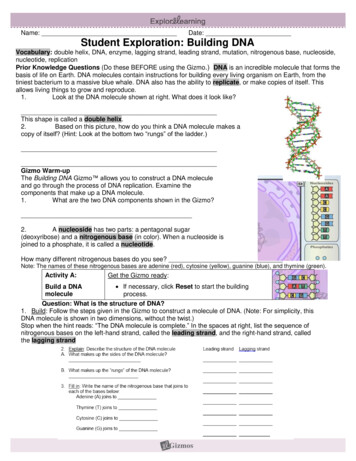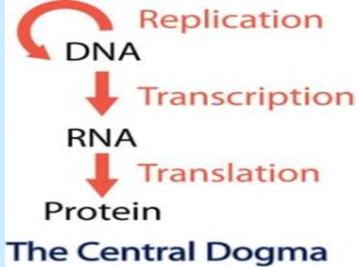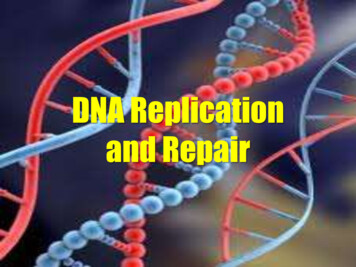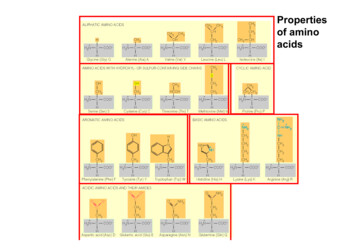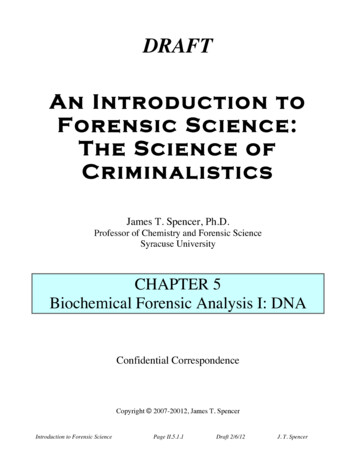
Transcription
DRAFTAn Introduction toForensic Science:The Science ofCriminalisticsJames T. Spencer, Ph.D.Professor of Chemistry and Forensic ScienceSyracuse UniversityCHAPTER 5Biochemical Forensic Analysis I: DNAConfidential CorrespondenceCopyright 2007-20012, James T. SpencerIntroduction to Forensic SciencePage II.5.1.1Draft 2/6/12J. T. Spencer
An Introduction to Forensic ScienceProf. James T. Spencer, Syracuse UniversityII. Biological EvidenceChapter 5: Biochemical Forensic Analysis I: DNA5.1. DNA: The Genetic RecordIntroduction5.2. How DNA WorksIntroductionDNA Background5.3. Forensic Applications of DNADNA Typing: Restriction Fragment Length PolymorphismDNA Typing: Polymerase Chain Reaction MethodsDNA STR TypingMini-STR and SNP DNA Profiling5.4. Mitrochondrial DNA and Y Chromosomal TypingMitochondrial DNAY Chromosomal TypingPlant and Animal DNA typing5.5. DNA Databanks: CODIS and BeyondCODISProject InnocenceSummaryInteresting DNA Cases for Further StudyReferences and BibliographyGlossary of TermsQuestions for Further Practice and MasteryCopyright 2007-20012, James T. SpencerIntroduction to Forensic SciencePage II.5.1.2Draft 2/6/12J. T. Spencer
Chapter 5.1. DNA: The Genetic Record“With the exception of nuclear DNA analysis, however, no forensic method has been rigorouslyshown to have the capacity to consistently, and with a high degree of certainty, demonstrate aconnection between evidence and a specific individual or source.” 2009, NRC Report StrengtheningForensic Science in the United States: A Path Forward.Learning Goals and ObjectivesThe use of DNA evidence has become the "gold standard" of forensic investigations. In orderto understand the wealth of information that can be gained from forensic DNA studies, you will needto demonstrate an understanding of:Ø Ø Ø Ø The chemical structure of DNA and how it holds genetic information,The transcription and translation processes of DNA,What parts of DNA are involved in forensic examinations,What are variable number tandem repeats (VNTR) and short tandem repeats (STR),Ø Ø Ø Ø Ø Ø Ø What a mutation is,How the Restriction Fragment Length Polymorphism (RFLP) method works,How the polymerase chain reaction (PCR)/STR method of DNA typing works,How frequency of occurrences of STRs in populations is determined and used,What is CODIS,How mitochondrial DNA can be used in forensic investigations,How DNA typing is being used in plants and other living organisms.Figure 5.1.1. DNA: the Blueprintof life (www.sciencephoto.com).Introduction to Forensic ScienceIntroduction. In the search for compelling scientificevidence, the criminal justice system has frequently looked toadvances in basic scientific research to lead the way to newforensic techniques. Nowhere has this progress been moredramatic than in the application of modern biochemicaltechniques to link the evidence gathered from crime sceneswith potential suspects. The explosive growth in creativework and new discoveries in biochemistry has lead to theaddition of many important new forensic tools. Thesemethods, such as DNA and blood analysis, have become sopowerful in providing the critical linking information that theyhave quickly become the “gold standards” of forensic evidencein courtroom proceedings. Juries have especially come todepend upon DNA evidence to be an integral part of all cases,regardless of what other evidence is available.The rapid advance of DNA evidence from its firstcourtroom appearance in 1987 to its commonplace use inforensic investigations today is unprecedented incriminalistics. From the first discovery that biological DNAPage II.5.1.3Draft 2/6/12J. T. Spencer
Case History:Colin Pitchfork and the DNA DragnetOn November 21st of 1983, 15-year old Lynda Mann never returned home from a friend'shome in Narborough, England. When her body was found the morning after her disappearance, itwas learned that she had been sexually attacked before being murdered. Analysis of biologicalsamples collected from the victim showed that the attacker must have been a young male whobelonged to a relatively rare blood type, referred to as A/PGM . Despite their best efforts, the policequickly came to a dead end in their investigation.Almost three years later, in 1986, the strikingly similar attack and murder of 15-year old DawnAshworth occurred in the same area of Narborough. This time the police had a suspect that theythought could be linked to both crimes, 14-year old Richard Buckland. Buckland. This unusuallylarge, not very intelligent youth, appeared to have more information about the murder than had beenreleased to the public. After two days of incoherent admissions and ramblings, he signed aconfession for the murder of Dawn Ashworth, but he maintained his innocence of the Lydia Mannattack. Since police believed that the same person committed both crimes, they turned to Dr. AlecJeffreys of the University of Leicester for help in trying to connect these two cases with Buckland.The analysis, based upon Jeffreys' longtime DNA research, confirmed that one man had indeedbeen responsible for both crimes, but that it wasn't Buckland! This was the first time that an innocentperson was exonerated by DNA evidence. Dr Jeffreys was quoted as saying "I have no doubtwhatsoever that he would have been found guilty had it not been for DNA evidence". It is nowbelieved that Buckland had witnessed the murder of Ashworth from a distance.Faced with this dilemma and no other leads, the police launched a massive campaign to screenmore than 5,000 local males for blood type and DNA profile. This mass screening, however, cameup without a match until a local bakery worker was overheard in a pub saying that he had been paidby a co-worker, Colin Pitchfork, to provide a blood sample for him. The police quickly brought inPitchfork and obtained an authentic blood sample: it matched. Pitchfork later confessed and wascharged with the rape and murder of both Lynda Mann and Dawn Ashworth. He was convicted aftera trial that lasted just one day.This case clearly illustrates the enormous strength of DNA evidence: it both exonerated aninnocent suspect and located and help to convict the real attacker.samples can be uniquely traced to one singlehuman with very high certainty in 1985 to it’sfirst use in a forensic investigation just one yearlater is truly a monumental achievement.Mankind has long sought for a way touniquely identify one person from another - ourappearance, signature, and fingerprints have allbeen used with varying degrees of success. Butit is with our DNA that we find the ultimatepersonal "signature". In fact, each person'sDNA is unique among the DNA of all humansthat have ever lived - no one (except possiblyan identical twin) has ever had the exact sameDNA composition as you.In this chapter, several of the mostimportant forensic bioanalytical techniques areIntroduction to Forensic ScienceFigure 5.1.2. New York City, Ground Zero.DNA analysis was critical in the identificationof remains from the World Trade Center attackin 2001. (from dna-partialmatches x.htm?POE TECISVA).Page II.5.1.4Draft 2/6/12J. T. Spencer
described, especially as they apply to courtroom.So what is biochemistry and molecular biology? Biochemistry and molecular biology arecommonly thought of as closely related fields of science that involve the study of chemicalcompounds and reactions that occur in living systems. Biochemistry is the point at which biology isreduced to its most fundamental level – the level of atoms and molecules. At this level, we areusually most concerned with how molecules are formed and then function to control all the processesthat collectively we call life. Simply stated, biochemistry is a study of the “chemistry of life”.In this chapter, we will explore howmodern biochemical tools are being appliedto forensic problems. How did a seeminglyabstract discovery that there are repeatedsections in our DNA makeup that does notcode for any known purpose lead to thedevelopment of one of the most importanttools in the forensic toolbox? How can thepresence of certain proteins contained inour blood be used to determine ancestry andlineage? How can we obtain uniquelyidentifying information from minutebiological samples collected at the crimescene? These are just a few of the basicquestions that will be addressed in thischapter in which we will explore the basic Figure 5.1.3. Dr. Alec Jeffreys of the Universityforensic chemistry of DNA, blood and of Leicester in England led the 1985 DNAbiological fluids.investigation of the Colin Pitchfork /iii d 210.jpg)Copyright 2007-2012, James T. SpencerIntroduction to Forensic SciencePage II.5.1.5Draft 2/6/12J. T. Spencer
5.2. DNA: How DNA WorksIntroductionUnraveling the secrets of DNA as the biochemical blueprint in governing the chemistry of lifecertainly ranks as one of the greatest accomplishments of modern civilization. This one amazingmolecule is central to all living things and is arguably the single most important molecule on Earth.It governs our chemical makeup, our biological functions, and even whether we will have brown hairor green eyes. It determines whether an organism will develop into a dog, a tree, or a human being.It can even determine whether an organism will be healthy or carry a biochemical disorder. Themore we learn of this one molecule, the more we come to see how fundamentally dominant it really isin all of life’s biological processes. Our intimate knowledge of the inner workings of the DNAmolecule has changed our lives in both subtle and dramatic ways, from the development of newdiagnostic and therapeutic drugs to the designed modification of life forms, such as bacteria, throughrecombinant techniques.Using a very simple analogy, DNA can be thought of as the massive biochemical cookbookthat contains the instructions for making all of the compounds that we require for life. Inside eachone of our more than sixty trillion cells resides one complete and identical copy of our DNAcookbook. Each recipe in our book, called a gene, contains specific directions for making just onebiochemical item, such as a protein or enzyme. If we look closely at a typical written cookbook, wesee that each recipe contains arrays and sequences of letters that are recognizable by us as words thatwe can, in turn, understand and translate into an action such as measure, mix, or bake. So, by thecareful arrangement and combination of the 26 basic letters of the alphabet on the page, we cancompletely and fully describe how to prepare just the item we wish to make. On a conceptual level,DNA works in much the same way as a cookbook, except that it uses just four “letters” instead of the26 alphabetic letters and all of the DNA “words” are just three letters long. But the instructions arejust as clear and complete. Our DNA cookbook is unique, however, in that the DNA “recipes” areseparated by long stretches of seemingly random letters that are unique from person to person andform the basis of how DNA forensic investigations work.In this chapter, we begin by describing the basic chemical features of DNA and how it worksto direct the chemistry of life. This is followed by the specific uses of DNA in forensicinvestigations. The field of forensic DNA is heavily laden with highly technical jargon that serves toconvey information between specialists both quickly and efficiently. This language is, however,often quite daunting and confusing to those who encounter it for the first time. In the followingdiscussions, however, this highly technical vocabulary of forensic DNA will be kept to the necessaryminimum needed to understand the important terminology and concepts of the field.DNA BackgroundIn recent years, forensic investigations have relied increasingly upon DNA evidence both toconvict and exonerate suspects. DNA (deoxyribonucleic acid), the genetic cookbook of life, oftenprovides vital information about crimes and suspects. While the fundamental structure of DNA hadbeen known since 1953, it had no significant place in the courtroom until the discovery by AlecJeffreys in 1985 that biological samples taken from people could be used for their individualidentification. In fact, prior to this work, DNA was thought to be very limited in forensicapplications because organisms generally don't tolerate well any deviations from the typical geneticcode. In other words, variations in the genetic DNA code usually leads to non-viable offspring. Forexample, if a cookbook recipe called for one cup of sugar and instead we used one cup of salt, theproduct of our work would certainly be uneatable. Similarly with DNA, changing one word couldIntroduction to Forensic SciencePage II.5.1.6Draft 2/6/12J. T. Spencer
easily render a critical protein biochemically useless. Luckily for forensic science, the regionsbetween DNA "recipes" provides a unique marker that can be used to establish “beyond a reasonabledoubt” a connection between a specific person and a biological sample collected at a crime scene. Inorder to understand how DNA is employed in forensic settings, however, an understanding of someof the basics about DNA itself is first necessary.DNA, along with carbohydrates and proteins, is one member of a class of importantbiomolecules referred to as biopolymers. These biopolymers are compounds that are formed bylinking together small molecular building blocks in a repeating fashion to form much largermolecules. This is conceptually similar to forming a long railroad train by linking together individualcars to produce a far larger assembly. The properties of the resulting biopolymer depends directlyupon the identity and chemical properties of the basic building block units that compose thebiopolymer. The properties also depend upon how the building blocks are connected together, suchas in a straight chain like a train or branched like a tree.Historically, the discovery of DNA itself has been attributed to Johann Miescher, anineteenth-century Swiss chemist. Prior to his work, it was believed that cells were made up largelyof protein - large biopolymer molecules made up of long chains of small linked amino acid buildingblocks. Miescher, however, found that certain extracts from the pus cells he was studying could not“belong among any of the protein substances known hitherto”. He showed that these fractions werenot made up of protein molecules since they were not digested by protease enzymes (enzymes thatspecifically break down only protein molecules). These particular extracts were also shown to arisesolely from the nuclei of the cells and were, therefore, named nuclein. Later work on nuclein byanother chemist, Albrecht Kossel, showed that nuclein was built of long chains of only four verysimilar building block molecules (nucleic acid units) and was later renamed a nucleic acid (DNA) byRichard Altmann. The structure we recognize today as the famous double helical arrangement of along, twisting biopolymer was finally explained in 1953 by James Watson and Francis Crick, workfor which they received the 1962 Nobel Prize in Medicine (Figure 5.2.1).TIMELINE OF DNA1868195319771985198519861987Figure 5.2.1. Watson andCrick with a model of the DNA1991double helix.1998(www.sciencephoto.com)2005Introduction to Forensic ScienceBRIEF ON DNAMiescher “discovers”DNA.Watson and Crick reportdouble helix structure.First human gene cloned.Jeffreys reports VNTRDNA sequences.First report of PCRmethod.Jeffreys uses DNA tosolve first murder case(Pitchfork case).First conviction on DNAevidence (Andrews case).STRs first reported.FBI starts CODISdatabase.2.5 million DNA “fingerprints” in FBI database.Page II.5.1.7(1) DNA is composed ofnucleotide building blocksthat are connected togetherinto chains.(2) Nucleotides contain aphosphate, sugar andnitrogen base units(3) Phosphate and sugar unitsform the DNA backbonechain and nitrogen bases“hang” from the backbone.(4) Pairing of nucleotide basesholds two strands of DNAtogether by hydrogen bonds.(5) Bases pair such that onlyadenine (A) pairs withthymine (T) and guanine(G) pairs only with cytosine(C).Draft 2/6/12J. T. Spencer
DNA, at its most fundamental level, is made up of repeating units called nucleic acids (Figure5.1) connected in a polymeric fashion. The term polymer (from “poly” meaning many and “mer”meaning unit) indicates a large molecule formed by linking together many smaller units (monomers)together into large arrays. In DNA, one nucleic acid unit is linked to another to form a long, linearchain, much in the way that railroad cars or alphabet letters are linked together to form trains orwords, respectively These nucleic acid building blocks are themselves composed of three simplercomponents (Figure 5.2.1): (1) a phosphoric acid residue (PO42-), (2) a five-carbon sugar unit(specifically, DNA uses a deoxyribose sugar such as shown at left in Figure 5.2.3), and (3) anitrogen-containing base. Together, these three components form what is known as a nucleotide(just the deoxyribose sugar and the nitrogen base together are called a nucleoside) – make sure youunderstand what a nucleotide is because it will be used quite often throughout this chapter. Thephosphate group and the deoxyribose sugar, when linked together in an alternating fashion, form aNH2PhosphateOO-1PONHOHONCH2N-1CH2NONitrogen BaseCHHHCCCCH2OHOC HH CC HH CH CCH CCHHOHHHOHOHOOHOHOHDeoxyribose SugarFigure 5.2.2. Nuclei acid (nucleotide) unit. Figure 5.2.3. Deoxyribose (L) and ribose (R) sugars.straight chain backbone for the DNA polymer. Attached to this backbone are attached nitrogen bases,somewhat similar to the way clothes are hung on a clothesline to dry. In fact, DNA uses only fourdifferent nitrogen base units: adenine, guanine, cytosine and thymine (RNA, a close relative of DNAand a molecule important in the transfer of information from DNA into biochemical action, usesuracil instead of thymine). These four bases are shown in Figure 5.2.4. All of the repeating units ofthe DNA backbone are completely identical (alternating phosphate and sugar units) while the pendantnitrogen bases are chosen from among this small group of four bases (A, T, G, and C). The entirefundamental structure of a strand of DNA thus consists of repeated phosphate-sugar-nitrogen basebuilding blocks that come together to form the observed complete DNA structure as shown in Figure5.2.5.ONH2NANOCH3NTNOOONOOONHOOGNCNCHNNH 2NCHCHHOHCHCNNHCNNNHCPOCH2NH2NNNNNH2NOFigure 5.2.4. Nitrogen bases used inDNA (clockwise from upper left):adenine, thymine, cytosine, and guanine.Introduction to Forensic ScienceHOHNNCPCOCH2OOCOCOCH2HNH 2HNCPHHNH2NFigure 5.2.5. Structure of DNA polymer – sugarphosphate backbone with pendant adenine nitrogenbases.Page II.5.1.8Draft 2/6/12J. T. Spencer
The order of the nucleotide units in the DNA chain can be readily specified by simply writingthe order of the nitrogen bases in the chain since all the other components are always the same. TheHydrogen OCNHONHNNTONGNHOHNHOCH 2ONNPHHHONNOOAOTHH2 CNPCH 3NOHONOOHNHOOH2 CNNNOOFigure 5.2.6. Hydrogen bonds formedbetween DNA bases pairs [C Cytosine, G Guanine, A adenine, T Thymine].Figure 5.2.8. Several views of the DNA doublehelix (http://www.psc.edu/ deerfiel/NIH/B-DNA.gif).POOHydrogen BondsOOPOFigure 5.2.7. Hydrogen bonded bases pairsbetween two strands of DNA[C Cytosine, G Guanine, A adenine, T Thymine].Figure 5.2.9. A gene is a sequence of nucleiacids along the DNA chain -dna/).sequence shown in Figure 5.2.5 is “AAA” since the three bases shown are all adenines, while a elydefinedas“AAACGTAACGTCGGTAAA”. Translated, this means that this latter DNA chain consists of threeconnected adenine nucleotide units, followed by a cytosine unit, followed by a guanine unit, followedby a thymine unit and so on until the end of the chain is reached.Introduction to Forensic SciencePage II.5.1.9Draft 2/6/12J. T. SpencerO
In a typical strand of the DNA polymer, huge numbers of nucleotide units are strungconsecutively together to form a very, very long chain. DNA strands in the nuclei of human cellsmay contain around 6 billion nucleotide units connected into long chains. These strands of the DNApolymer are usually found in nature not as individual strands but rather as complementary pairs ofstrands, meaning that two DNA chains are required to come together in order to form the observedcomplete double helical DNA structure. These strands don’t just come together in any randomfashion but are instead directed together by very specific chemical interactions between the twochains. To form the double strand arrangement, two nitrogen bases, one from each chain, must cometogether to form a close electrostatic attraction, called a hydrogen bond. Only very specific pairs ofbases can interact in this fashion as dictated by their chemical structures. In this way, only cytosineand guanine are chemically built to allow a close interaction – close enough to form a hydrogen bondthat electrostatically holds together the two bases, and therefore, also holds together the two DNAchains.Likewise, adenine and thymine can form a hydrogen-bonded unit. These interactions areshown in Figure 5.2.6 for the only two possible combinations. If, however, cytosine and thymine orguanine and adenine are forced to come together, no hydrogen bond can be formed since theirstructures do not allow for the proper electrostatic “fit”. This would be like trying to plug a 3pronged electrical cord into a 2-pronged outlet; it just doesn't work. When every adenine (A) on oneDNA strand is matched with a thymine (T) on the other strand and every cytosine (C) is onlymatched with a guanine (G), the two strands are said to have a complementary sequence of bases.Having a complementary sequence on the two DNA strands yields a new double chain that iseffectively “pinned together” through the hydrogen bonding of the nitrogen base pairs. This is shownschematically in Figure 5.2.7. When these two complementary strands of DNA come together, theyform the well-known double helical structureshown in Figure 5.2.8 (like a twisted flight ofstairs).The sequence of nitrogen bases in the DNApolymer is the fundamental basis for controlling allof life’s cellular processes and ultimatelydetermining things like what color eyes we have orhow tall we might become. The basic DNA unitthat determines which characteristics aretransmitted to succeeding generations is called aDNA, Gene, Chromosome, Genome?Figure 5.2.10. Nuclear . A gene is simply a small portion of theDNA strand, a sequence of nucleic acids, thatcontains the DNA coded message forsomething inherited (Figure 5.2.9). Each generegulates the formation of a specific enzyme orprotein within the cells of the body, ultimatelyleading to the direct regulation of all of life’sbiochemical processes. At their simplest level,Introduction to Forensic ScienceIt may seem confusing, but there’s arelatively simple explanation. DNA is asequence of nuclei acids. A particularlength, or sequence, of DNA is called a gene– a “word.” The genetic and non-geneticlengths of DNA form form a strand of DNA– a “sentence.” A long chain of DNA that ispart of the entire DNA compliment of a cellis called a chromosome – a “chapter.” Allthe chromosomes make up the genome – theentire “book.”Page II.5.1.10Draft 2/6/12J. T. Spencer
our genes are really just composed of chemical “address” where we find a message written. TheRecipe Book monjkjggdfds.encoding regiongeneencoding regiongeneFigure 5.2.11. Coding and non-coding regions of an interesting recipe book.basic genetic language of this message consists of just four letters (adenine, thymine, guanine, andcytosine) that provides all the chemical information necessary to exactly prepare a specific moleculerequired by the cell. Thus, a small region of the DNA strand forms a gene that is the blueprint formaking a molecule (Figure 5.2.9). The location of a gene on a DNA strand isreferred to as its locus (the plural is loci) with the genes residing along very specific stretches of theDNAchain(Figure5.2.10).Aparticularlyimportant discovery in1985 to forensic sciencewas that the relativelyshort coding regions ofDNA (genes) are oftenfound separated from eachother by long stretches ofDNA that do not encodeforanythingknown.These separating regionsare called “non-coding” orhypervariableregions(sometimes also called“junk” DNA in the popularpress)andwillbediscussed in detail later.Figure 5.2.12. HumanThe relationship betweenchromosomes showing the 23 pairscoding and non-codingin the human genome (ComputerDNA regions is illustratedartwork) composed of DNAschematically in Figure(deoxyribonucleic acid) that and5.2.11 using the cookbook Figure 5.2.13. The coiling ofprovides the information necessaryanalogy. In this analogy, DNA helices to form nuclearfor the cell to make the chemicalsthe first part of the strand pictures/DNA.gif).necessary for life (sciencephoto.com; No. P656/199)of letters is meaningless tous until we reach a section that encodes for words we doIntroduction to Forensic SciencePage II.5.1.11Draft 2/6/12J. T. Spencer
understand ("spread jelly on bread"), called the coding region. After this understandable sectionfollows another nonsense region (non-coding region) until we reach another understandable region("add water and lemon"). In a similar fashion, DNA has long nonsense regions located betweensmaller genetic regions that code for something our do cells understand - biosynthesisThe DNA of an organism is at times found all coiled up to form chromosomes that is foundeither in the nucleus (nDNA) or in the mitochondria (mtDNA) of the cell (Figures 5.2.10 and 5.2.12).All cells of an individual organism have identical DNA, so it doesn’t matter what cell the DNA isfrom, they all have exactly the same DNA code. Chromosomes are similar to the chapters of a book– convenient ways to “package” the story into smaller, more readily handled units. In humans, theDNA in most of our cells is arranged into 23 pairs of chromosomes that are identified by theircharacteristic sizes and shapes. One pair is referred to as the sex chromosome and can either be of alarger variety (the “X” chromosome) or a smaller version (“Y” chromosome). Females have two “X”chromosomes while males have a size mismatched “X” and “Y” pair. One-half of our geneticinformation comes from our mothers and one half from our fathers, with the “Y’ chromosomeinheritable only from fathers to sons (Figure 5.1.13).So how do we get from the basic chemicalarrangement of DNA just discussed to the color ofBRIEF ON DNATRANSCRIPTION/TRANSLATION(1) Information in the order of nucleotides inDNA can be transcribed and translated todirect the preparation of proteins in the cell.(2) Every three nucleotides in DNA codes for oneamino acid in the formation of a protein.(3) The section of DNA coding for a protein iscalled a gene.(4) DNA contains very large regions that code fornothing known.our eyes? The pathway that leads from DNA"letter" sequences to the synthesis of cellularproteins that regulates life employs two veryimportant processes called transcription andtranslation. In a very brief summary, DNA cellularcontrol works something like this. In the firstprocess, called transcription, a portion of the DNAdouble helix is first unraveled into single strands inthe region that codes for the needed cellularcompound (the gene). A brand new strand, called acomplimentary strand, forms with A’s pairing withU’s (since this is RNA that uses uracil in place ofDNA's thymine) and G’s pairing with C’s betweencothe original template and the newly forming strand.Figure 5.2.14. Schematic drawing showingThe new strand (called messenger RNA or mRNA)the transcription of DNA into mRNA.is an exact complimentary match to the original(www.geneticsolutions.com/PageReq?id 1530:1873)template in which every C in the original is matchedto a G in the new strand and so on, as shown in Figure 5.2.14. This process can really move alongIntroduction to Forensic SciencePage II.5.1.12Draft 2/6/12J. T. Spencer
very quickly, with an estimated 90,000 bases added per minute. The mRNA is somewhat like anegative image in photography that is formed from an actual (positive) scene. The negative carriesall of the original visual information of the scene but only in reverse. The original positive image caneasily be regenerated from the negative by using light and special photographic paper. The newlyformed mRNA then moves out of the nucleus of the cell to an organelle in the cell’s cytoplasm calledthe ribosome. On the ribosome, each group of three nitrogen bases in the mRNA strand uniquelydesignates one specific amino acid in the protein polymer molecule being synthesized. These aminoacids are then chemically linked together in a new polymeric chain to form the needed protein in aprocess known as translation. For example, the mRNA code “GGG” translates directly into thecommand that a glycine amino acid needs to be placed in the growing chain while an “AAA” codespecifies that a lysine amino acid be placed next in line. In this manner, the mRNA sequence“AAAAAAGGGAAA” would translate to a small protein composed of two glycines, followed by alysine and ending with another glycine unit. It’s important to see that the order of the bases in theDNA molecule is ultimately translated into a very specific sequence of amino acids that are linkedtogether to form a new protein molecule. This is
Introduction to Forensic Science Page II.5.1.3 Draft 2/6/12 J. T. Spencer Chapter 5.1. DNA: The Genetic Record “With the exception of nuclear DNA analysis, however, no forensic method has been



